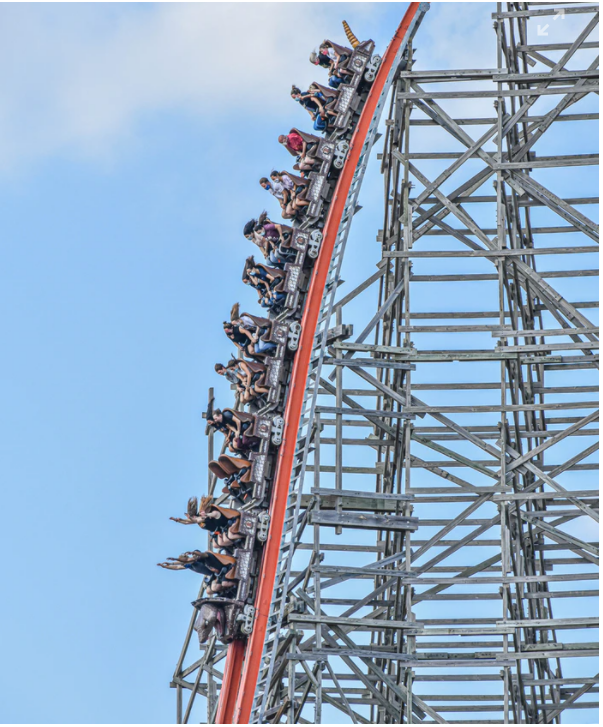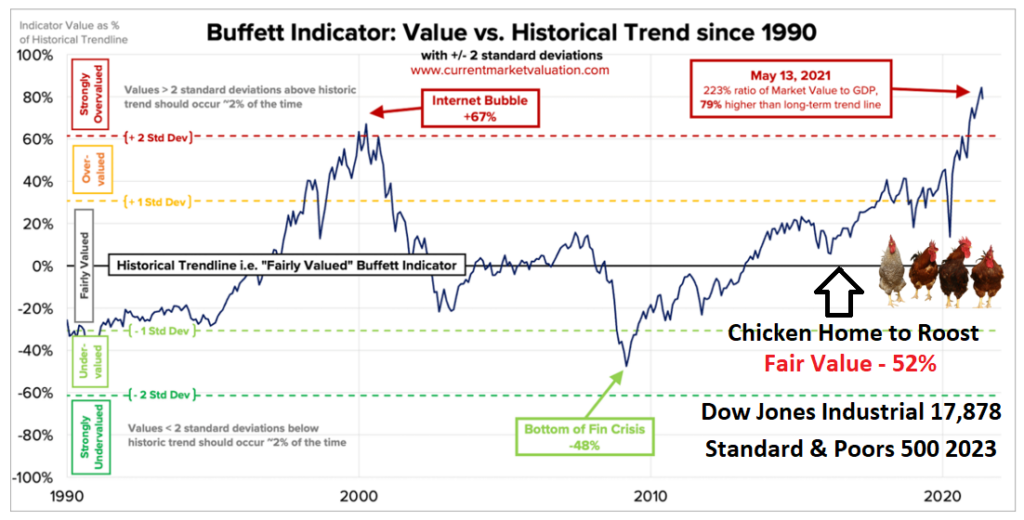GDP’s $22 Trillion vs Total Stock Market Value (TMC) of $50 Trillion
How Does This Compute (hint, not too well)?
Buffett’s Value Index. Updated Weekly. Last updated: May 13, 2021
The Gross Domestic Product – GDP – is the “the total market value of goods and services produced within the borders of a country.” The current GDP for the U.S. is $22.6 trillion (annualized).
The TMC is the total market cap of all U.S. based public companies listed on New York Stock Exchange, Nasdaq Stock Market or OTCQX U.S. Market. The current TMC is $50.5 trillion.
The indicator measures the value of the GDP compared to the value of the TMC. No rocket science there.
(And not to confuse but important to continually – keep track of what amount of the GDP is being produced from the private sector and what amount is from the US government spending. )
On the surface to the everyday investor, it doesn’t sound like a big deal, at a multiple of ‘just’ two times the value of the GDP, right?
As pointed by Warren Buffett, the percentage of total market cap (TMC) relative to the GDP is “probably the best single measure of where valuations stand at any given moment.”
The Buffett Indicator could be called the Value Index. The normal or historical market value of the total stock market, is 1.2 times the value of the GDP.
So basic math says the value of the total stock market should be $26 trillion to be called fairly valued – versus the current value of $50.5 trillion – an astounding premium no matter how you slice it.
If the market for whatever reason (and we can think of many) declines towards where it could be called undervalued, it could trade to a 46% discount or .64 times the $20 trillion value of the GDP.
So basic math says an under-valued TMC market would chime in at $14 trillion versus the current value of $50.5 trillion – an astounding risk no matter how you slice it.
WHAT CAN THE FUTURE HOLD?
What the everyday investor should be aware of is that while the GDP doesn’t really change much on a yearly basis (-2% to +4%) – the current market multiple of two times over the GDP — is 79% higher today than normal.
And that is a big deal. Not to mention the market has, in very recent history, fell to as low as 48% below normal (as in way undervalued in 2008).
If the current stock market swings from overvalued where it is today to the fair valued we are looking at a loss of 52%. If it continues down past fair valued, to undervalued – like from 2000 to 2008 – we are talking CATASTROPHIC losses and buh-bye to a normal retirement.
Under such scenarios a $1 million 401K at fair value would chime in at $460,000 and at under-valued would chime in at $294,000.
HAS THIS EVER HAPPENED BEFORE?
1972, $1,000,000 to $607,000
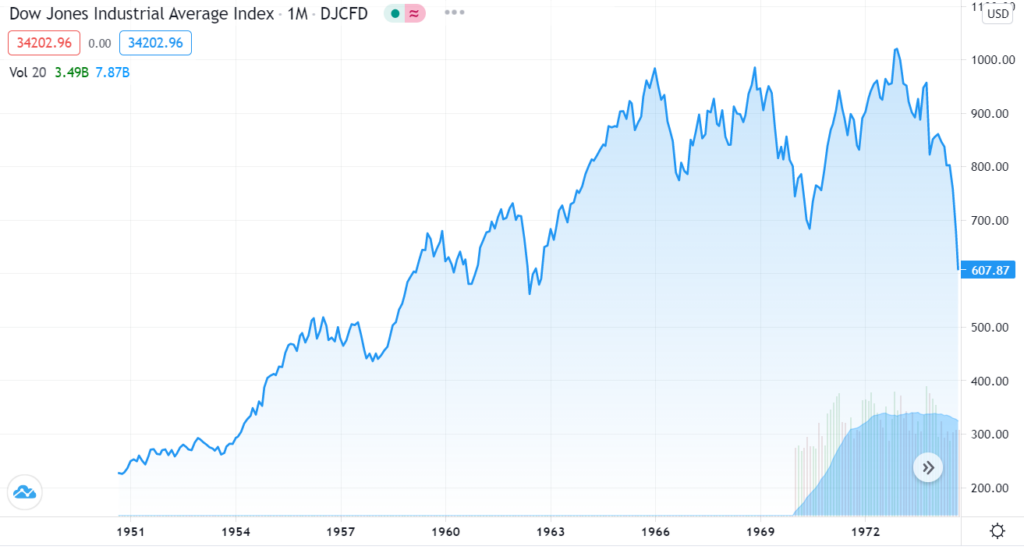
1987, $1,000,000 to $670,000
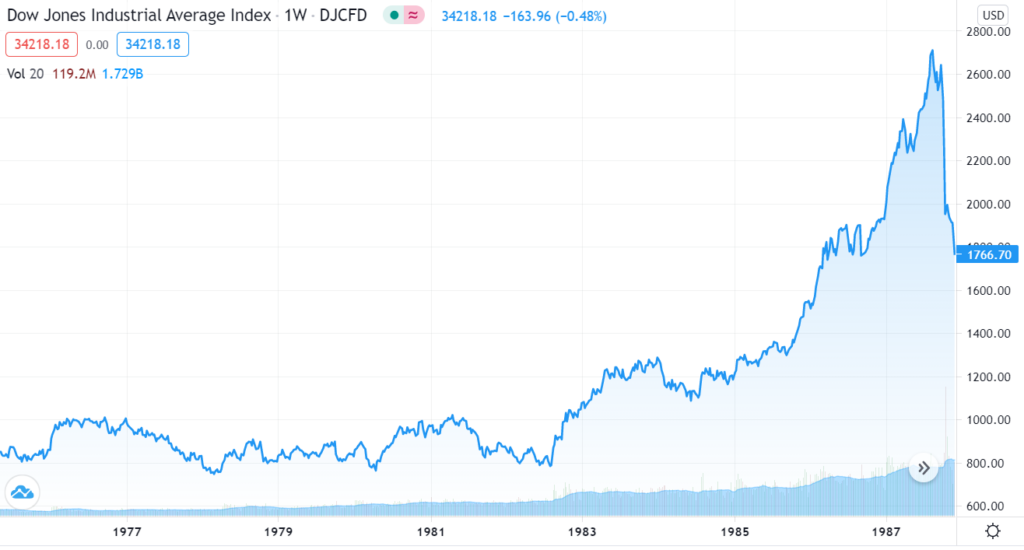
2000, $1,000,000 to $520,000

2008, $1,000,000 to $470,000
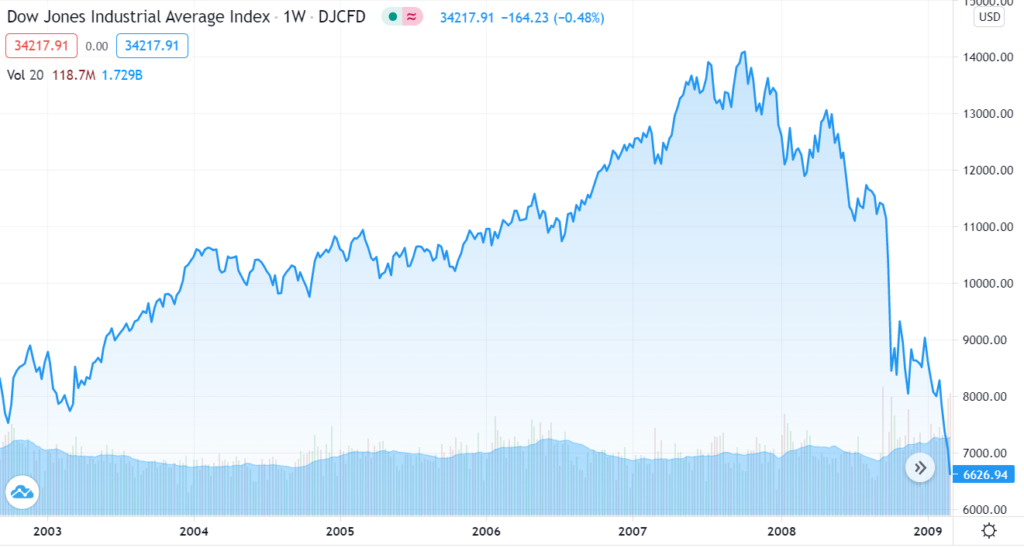
Currently, the Dow is at 34,383 and the S&P 500 at 4,730
Fair value puts the Dow at 18,000 and the S&P 500 at 2,000.
Undervalue puts the Dow at 11,084 and the S&P 500 at 1,254
Note while the GDP’s growth will vary from year to year (including dropping during a recession) it’s true that over long periods of time, the GDP will ultimately grow (see chart below) as more and more people are born, and as these people consume more and more goods and services. Pretty simple. But that’s not the point.
THE GDP GOES UP AND UP. MARKETS HOWEVER DO NOT

The point is while GDP may have its ups and downs, (since the 60’s a bad year is -2% and a good year +4%) the volatility is nothing compared to the stock market where a single bad year can be down -37% (2008) and a single good year can be up +37% (1995).
Stepping outside annual limitations, since bull and bear markets don’t respect the calendar, the bear markets of 1971 were down 48%, 2000 was down 49% and 2007 was down 56%.
One might think the a broad stock market would roughly follow the GDP..
Well not really. In fact not at all.
The markets move up when investors are greedy and fall when investors are scared. It’s really that simple – it’s politically correct to call this investor sentiment.
The Buffett Indicator above is a good gauge then of just how greedy investors are today. Buffett says it’s the best measure of valuation. We say it’s the best measure of greed and complacency, fear and panic.
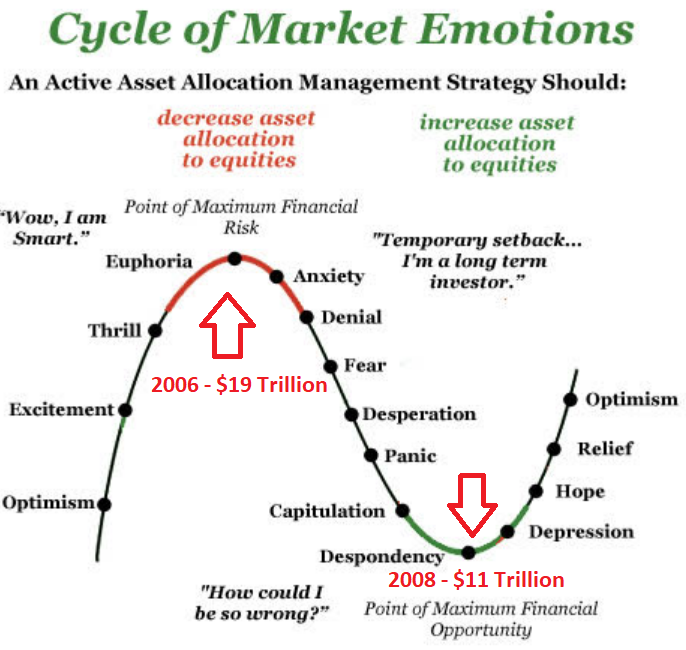
Billions (trillions actually) can be made when sentiment changes from absolute fear to absolute greed (2009 to 2021) and trillions can be lost when (if) it changes from absolute greed and complacency (2021) to absolute fear.
From 2009 to today, the TMC – total market value of stocks has risen from $15 trillion to $50 trillion a gain of $35 trillion in just ten years – while the GDP has risen from $15 trillion to $20 trillion a gain of just $5 trillion.
During the last trip from fair value to undervalued (2006-2009), the value of all stocks fell from $19.6 trillion to $11.4 trillion wiping out $8.2 trillion in the process.
LESSONS TO BE LEARNED
Here’s the fortunate and valuable thing we’ve learned about fear and greed – learned after losing our college tuition, trading IBM calls back in 1973:
The market does not swing from one absolute to the other like a pendulum. If life were so easy, investors would only invest when the value index is near peak absolute fear and sell only when the value index is near peek absolute greed!
As such, the only logical thing to do is investing and/or trading only when the market is in the undervalued buy zone and selling only when the market is overvalued sell zone.
CONSIDER ONLY BUYING IN THE UNDER VALUED ZONES & SELLING ONLY IN THE OVER VALUED ZONES

THE MARKET MOVES LIKE THIS
FINAL THOUGHT & LESSON..
If you think sticking to only ‘quality’ and riding it out will save you – think again. We saw what happened to investors (we are after all the Internet Stock Review) during the last market that was valued like today – which was the year 2000 and called the Internet dotcom boom.
Today we have the ARKK Fund run by Cathie Wood, back then we had the Amerindo Technology Fund run by Alberto Villar. The similarities are frightening, for ARKK shareholders that is.
It was sad to see what happened to Vilar and some of our close friends (professionals) who believed their ‘hold for the long haul’ strategy for both themselves and their clients. They bought when the market was overvalued.
Then they averaged down as the market dropped to fair value. Then as the market continued going down and when the pain and losses were so great – they finally SOLD just when the market became – you guessed it – undervalued. Now, WHAT kind of strategy, we ask is that?
Here then is Cisco (CSCO) versus Tesla (TSLA).
CISCO’S WONDERFUL & MAGNIFICENT RUN UP FROM $10 TO $70

TESLA’S WONDERFUL & MAGNIFICENT RUN-UP $100 TO $700
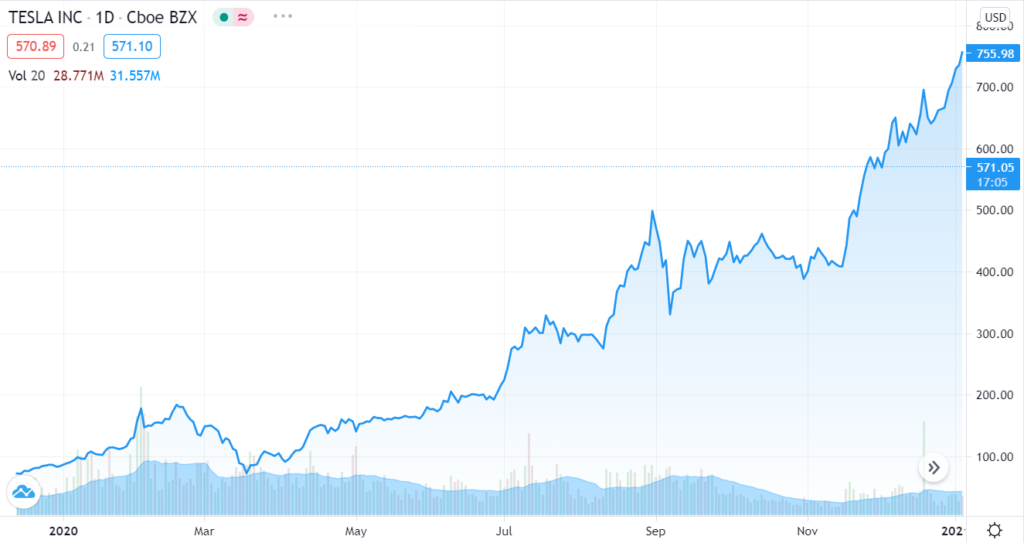
‘QUALITY’ REDEFINED BY MARKET FORCES
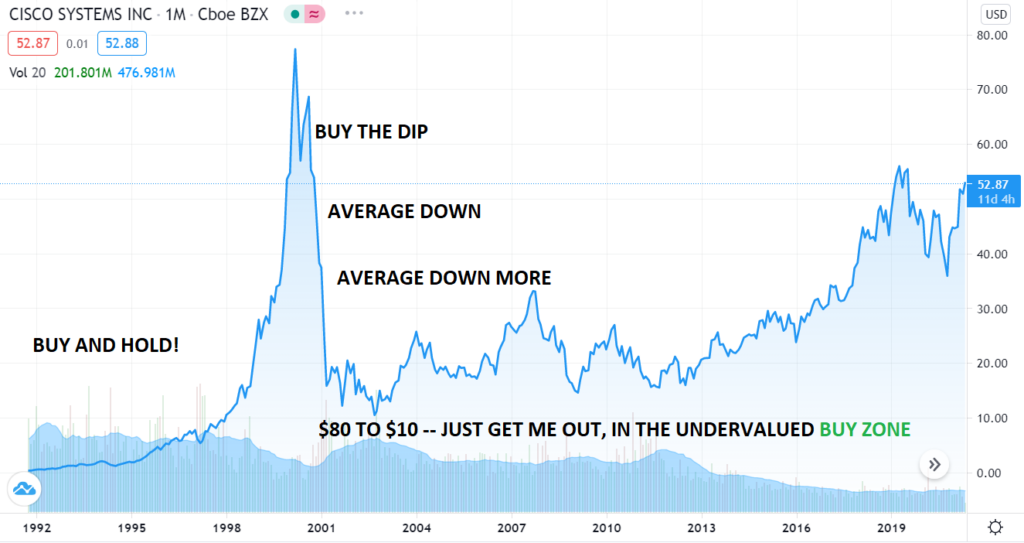
In real terms, as opposed to looking at the above squiggly chart — that’s a market value falling from $800 million to $100 million in an institutional portfolio, $80 million to $10 million in a whale’s portfolio, and $80,000 to $10,000 in a retail portfolio. Real money, real losses from Cisco’s indisputable quality.
Final note, we are still heavily involved in ‘event’ stocks like the ‘pre-FDA approval’ kind. So we are by no means on the sidelines. But it has to be a pretty damn big event we’re anticipating – or extremely undervalued for us to be interested.
Companies and clients like Citius (CTXR) which is seeking approval to disinfect catheters, Provention (PRVB) which is seeking approval to provide a solution for Type 1 Diabetes, urban-gro (UGRO) which is helping the nation’s farmers move to indoor growing, Aphex Corp (SNST), which has the world’s best-uncompromised sanitizer, Hepa Pharma (HEPA) which is seeking approval to reduce liver fibrosis, Draganfly (DFLYF) which makes the world’s finest drones, CB Scientific (CBSC) which enables patients to monitor their heart function from home, Hapbee (HAPBF) which enables us to feel like we had a cup of coffee or dose of nicotine via a wearable device (it really works), OMNIQ (OMQS) who has the world’s best AI-powered camera’s to spot perpetrators and inform the police in seconds, and beverage startups like the Alkaline Water Co (WTER) which makes the world’s best alkaline water and Tinley Beverage (TNYBF) which makes THC powered beverages that will knock your shoes off. And let’s not forget stem-cell related companies!
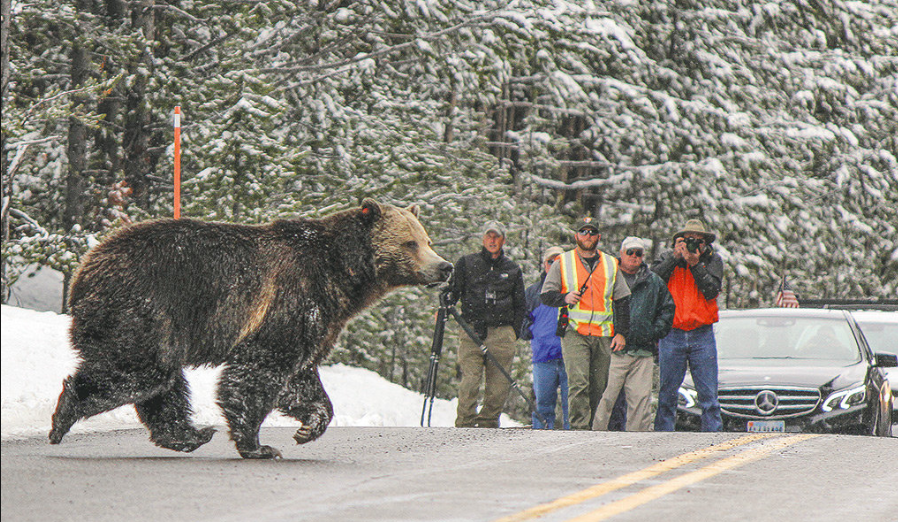
The bear smells blood and is circling and looking for dinner. Don’t be his dinner. We have a strategy to make money when the proverbial hits the fan. More than we’ve ever made. The next decade will be all about precious metals, commodities and a dabble into digital currencies.
We started in the business on the floor of the CBOE when the exchange opened in 1973, right before one of the worst stock market downturns since the Great Depression. And this one lasting 694 days!
It was like a slow-motion mudslide. Every day we came in, we watched the market go down just a little bit, just another percent, then we left after the close and took the CTA home (after cocktails at Ceres of course). Day after day, after day. For two years!
So while we’re not scared of nuttin, this time instead of hiding, we plan to make bank from what could be one of the biggest bear markets and transfers of wealth ever.
We came in during a bear market and we’ll be going out during a bear market. Full circle, unscathed! It’s been a great run, with more fun times ahead. For some.
We got this…get our letter to see where we go.
RELATED: Broker Robinhood Versus Buffett Over Casino Comparison



